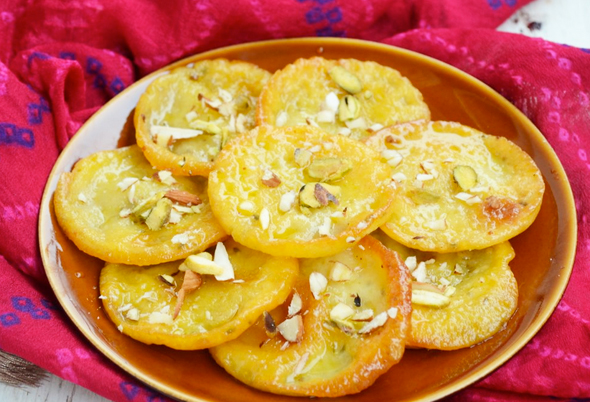Mama’s Punjabi Recipes: Maal Pudde (Fried Sweet Flatcakes)
Saved under Community, Current Stories, Recipe Corner
Tags: Baytown, Clear Lake, Cypress, Desi news, Greater Houston, Houston, Houston Desi news, India, Indian American community, Indian News, Indians in America, Indo-American News, Katy, Maal Pudde, Mama’s Punjabi Recipes, NRI, pearland, Shakuntla Malhotra, south asia, South India, Sugar Land, Texas, USA
Those who enjoy their savory snacks know that the taste of a namkeen pudda (salty flatcake) is between that of a pakora (fried fritter) and a soft parantha. Part of this is because pudde are made on a tava (flat plate) much like a parantha is and the other part is that the dough mixture is very similar to that of a pakora, though sometimes puddas are made with a daal (lentil) paste.
But the amazing thing is that when you fry the same mixture, it has a different taste and of course, texture. Take for example, the same lentil paste: when fried it can become a bhalla (fried lentil dough ball) and if it is made with less water, it comes out hard like the common South Indian vadda.
In the same way, many people aren’t familiar with maal pudde (fried sweet flatcakes) – and shouldn’t confuse them with jalebis (fried sweet dumplings) – as it is not a sweet snack that is made too often now, even among Punjabis. Maal pudde are actually made with the same dough as the salty pudde, but the only difference is that they are fried and made with chasni (sugar syrup).
The results are quite pleasing as the texture and taste make this an ideal snack to have on a cold, rainy Monsoon day with a bowl of kheer (rice pudding) and a cup of hot tea. The more popular snacks in the rainy season, of course, are pakore and samosas (stuffed triangular pies) but the maal pudde are tough to beat!
Ingredients:
2 cups atta or maida (wheat flour or bleached flour)
2 cups chinni (sugar)
2 cups pani (water)
Vegetable or sunflower oil for frying
Flavoring:1 tsp saunf powder (fennel seed – thin ones are better)
Directions:
1. To make the chasni, pour sugar into a bowl and slowly add warm water while mixing thoroughly with a spoon.
2. Slowly add in the atta and beat it with a tablespoon, making sure not to leave any lumps, so that you get a smooth mixture.
3. Add in the saunf powder and mixture well.
4. Pour the oil a small karahi (wok) or a wide flat frying pan and warm it up over high heat.
5. When the oil is hot, take a small amount of the mixture with a large spoon and pour it in a 3-inch diameter disk.
6. Let the round disk fry till it is golden brown on both sides, turning as needed. Once done, take it out with a slotted ladle and place on a paper towel to soak the excess oil.
7. Now repeat with the rest of the mixture. You can make two or three of the disks at the same time.
8. Once the maal pudde are cooled down a bit, serve with tea or coffee.
MAMA’S TIP OF THE WEEK
FOR EXTRA QUICK MAAL PUDDE, USE A SHALLOW KARAHI (WOK)
The depth of karahis, the Indian style woks or wide-rimmed iron or steel bowls, comes with their own purpose. To make large amounts of halwa (flour pudding) for a religious offering or to evaporate a lot of milk quickly to make a rabddi (thickened milk) or khoya (congealed milk), a deep karahi is best.
In the case of maal pudde, or other items that you want to fry but not use too much oil and can easily fish the items out, it is best to use the shallow karahi. We would call a tavi – but these are not commonly available now. Instead, it is best to use a shallow frying pan when making maal pudde.

Shakuntla Malhotra is a skilled cook of Punjabi dishes made in the old-fashioned style that she learnt as a young woman in her ancestral home in Lyallpur (since renamed Faisalabad), India before it became part of Pakistan after the Partition in 1947. People have often admired her cooking for its simplicity and taste that comes with each mouthful. Even in her mid-eighties, she continues to cook daily and agreed to share some of her delectable Punjabi recipes

